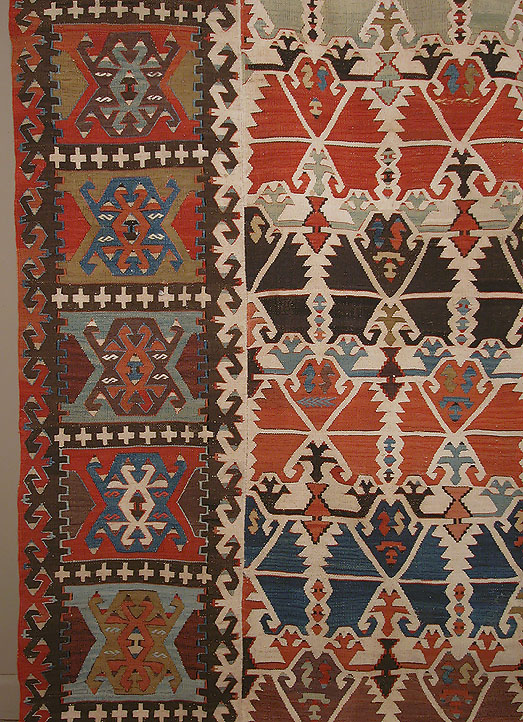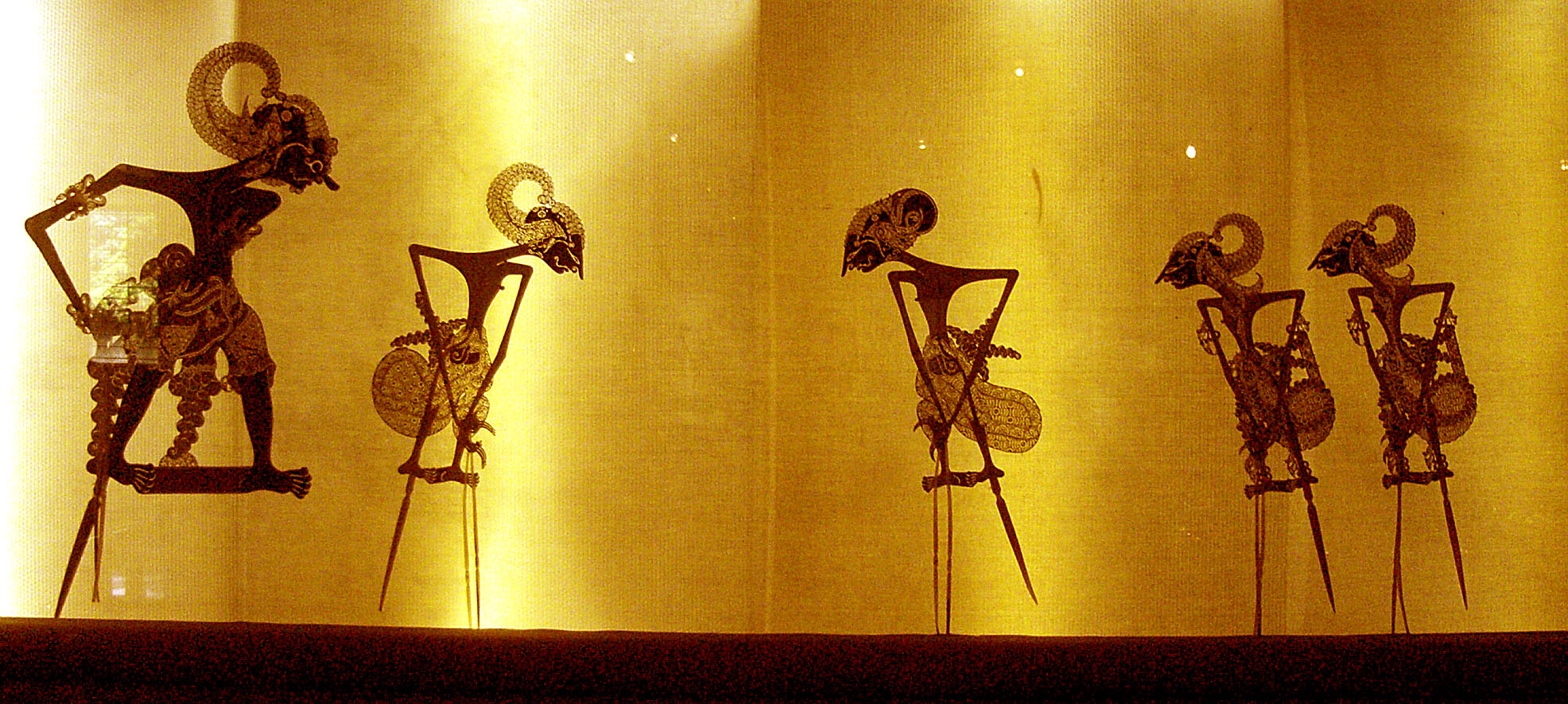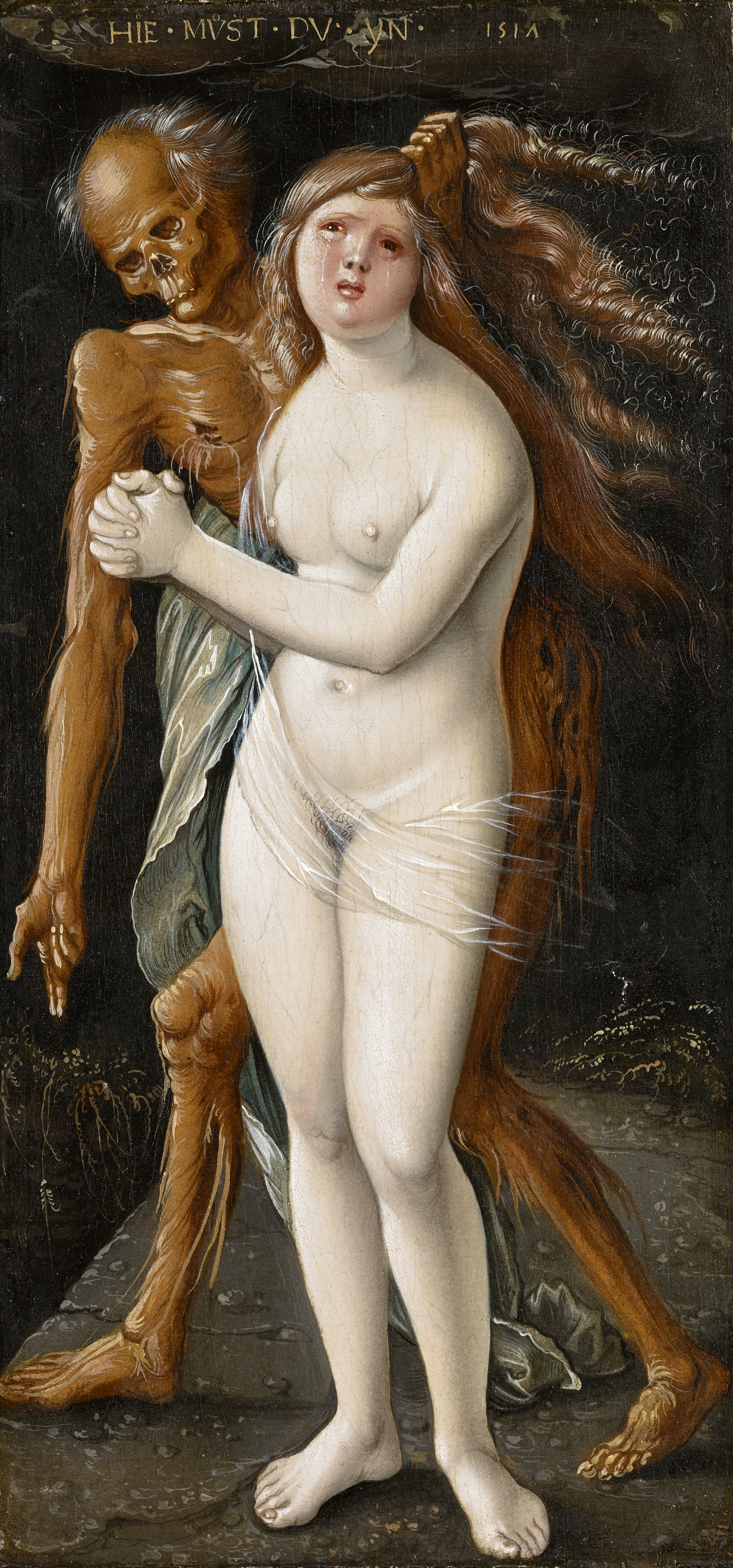|
Motif (art)
In art and iconography, a motif () is an element of an image. The term can be used both of figurative and narrative art, and ornament and geometrical art. A motif may be repeated in a pattern or design, often many times, or may just occur once in a work. A motif may be an element in the iconography of a particular subject or type of subject that is seen in other works, or may form the main subject, as the Master of Animals motif in ancient art typically does. The related motif of confronted animals is often seen alone, but may also be repeated, for example in Byzantine silk and other ancient textiles. Where the main subject of an artistic work such as a painting is a specific person, group, or moment in a narrative, that should be referred to as the "subject" of the work, not a motif, though the same thing may be a "motif" when part of another subject, or part of a work of decorative art such as a painting on a vase. Ornament (art), Ornamental or decorative art can usually b ... [...More Info...] [...Related Items...] OR: [Wikipedia] [Google] [Baidu] |
Iconography
Iconography, as a branch of art history, studies the identification, description and interpretation of the content of images: the subjects depicted, the particular compositions and details used to do so, and other elements that are distinct from artistic style. The word ''iconography'' comes from the Greek ("image") and ("to write" or ''to draw''). A secondary meaning (based on a non-standard translation of the Greek and Russian equivalent terms) is the production or study of the religious images, called "icons", in the Byzantine and Orthodox Christian tradition (see Icon). This usage is mostly found in works translated from languages such as Greek or Russian, with the correct term being "icon painting". In art history, "an iconography" may also mean a particular depiction of a subject in terms of the content of the image, such as the number of figures used, their placing and gestures. The term is also used in many academic fields other than art history, for example semioti ... [...More Info...] [...Related Items...] OR: [Wikipedia] [Google] [Baidu] |
Pakudos
A pakudos is a visual motif used by the Hanunuo Mangyan people of Mindoro in the Philippines. Pakudos are characterized by symmetrical, aesthetic, and orderly utilization of lines and space with equal utilization of vertical and horizontal composition. The word pakudos was coined from ''cruz'', the Spanish word for cross. The pakudos motif is a common element in Mangyan embroidery and crafts. It is also featured on the official seal of San Jose, Occidental Mindoro. Revitalization efforts This design element is added in various modern products such as bags, baskets, bracelets, jars and clothing. It can also be made into a tattoo or as an art project like sculptures, houses, and bamboo craft. The Project Pakudos also showcases tribal art of the Mangyan people, as well as its indigenous script, Hanunuo or Surat Mangyan. The Mangyan Heritage Center located in Calapan, Mindoro collaborates and advocates traditional weaving patterns and embellished style to mainstream arts & craf ... [...More Info...] [...Related Items...] OR: [Wikipedia] [Google] [Baidu] |
Elibelinde
Elibelinde (Turkish for "hands on hips") is a Turkish motif of a hands-on-hips female figure. It is widely used on kilims (flat tapestry-woven carpets) and occurs in many variations. The arms of the figure are represented by two inward-facing hooks, while the body of the woman is represented by a triangle or diamond. The head is typically represented by a diamond. The Elibelinde is a symbol of fertility and motherhood. It is one of many kilim motifs Many motifs are used in traditional kilims, handmade flat-woven rugs, each with many variations. In Turkish Anatolia in particular, village women wove themes significant for their lives into their rugs, whether before marriage or during marri ... commonly woven into Turkish flatweave rugs. Elibelinde1.svg, Elibelinde2.svg, Elibelinde3.svg, Elibelinde4.svg References {{Islamic art Turkish rugs and carpets ... [...More Info...] [...Related Items...] OR: [Wikipedia] [Google] [Baidu] |
Kilim Motifs
Many motifs are used in traditional kilims, handmade flat-woven rugs, each with many variations. In Turkish Anatolia in particular, village women wove themes significant for their lives into their rugs, whether before marriage or during married life. Some motifs represent desires, such as for happiness and children; others, for protection against threats such as wolves (''to the flocks'') and scorpions, or against the evil eye. These motifs were often combined when woven into patterns on kilims. With the fading of tribal and village cultures in the 20th century, the meanings of kilim patterns have also faded. In these tribal societies, women wove kilims at different stages of their lives, choosing themes appropriate to their own circumstances. Some of the motifs used are widespread across Anatolia and sometimes across other regions of West Asia, but patterns vary between tribes and villages, and rugs often expressed personal and social meaning. Context A Turkish kilim is ... [...More Info...] [...Related Items...] OR: [Wikipedia] [Google] [Baidu] |
Kilim
A kilim ( az, Kilim کیلیم; tr, Kilim; tm, Kilim; fa, گلیم ''Gilīm'') is a flat tapestry- woven carpet or rug traditionally produced in countries of the former Persian Empire, including Iran, the Balkans and the Turkic countries. Kilims can be purely decorative or can function as prayer rugs. Modern kilims are popular floor coverings in Western households. Etymology The term 'kilim' originates from the Persian ''galīm'' (گلیم) where it means 'to spread roughly', perhaps of Akkadian or Aramean origin. another name for Galim(Gilim) is Plas, Ferdowsi and other persian poet mentioned both Galim and plas as synonyms in Shahnameh No 35 mentioned as Plas(pluNo14 mentioned as Gali History Like Pile weave, pile carpets, kilim have been produced since ancient times. The explorer Mark Aurel Stein found kilims dating to at least the fourth or fifth century CE in Hotan, China: :"As kilims are much less durable than rugs that have a pile to protect the warp and weft, i ... [...More Info...] [...Related Items...] OR: [Wikipedia] [Google] [Baidu] |
Islamic Culture
Islamic culture and Muslim culture refer to cultural practices which are common to historically Islamic people. The early forms of Muslim culture, from the Rashidun Caliphate to the early Umayyad period and the early Abbasid period, were predominantly Arab, Byzantine, Persian and Levantine. With the rapid expansion of the Islamic empires, Muslim culture has influenced and assimilated much from the Persian, Egyptian, North Caucasian, Turkic, Mongol, Indian, Bangladeshi, Pakistani, Malay, Somali, Berber, Indonesian, and Moro cultures. Islamic culture generally includes all of the practices which have developed around the religion of Islam. There are variations in the application of Islamic beliefs in different cultures and traditions. Language and literature Arabic Arabic literature ( ar, الأدب العربي / ALA-LC: ''al-Adab al-'Arabī'') is the writing, both prose and poetry, produced by writers in the Arabic language. The Arabic word used for literature is ... [...More Info...] [...Related Items...] OR: [Wikipedia] [Google] [Baidu] |
Saint Joseph
Joseph (; el, Ἰωσήφ, translit=Ioséph) was a 1st-century Jewish man of Nazareth who, according to the canonical Gospels, was married to Mary, the mother of Jesus, and was the legal father of Jesus. The Gospels also name some brothers of Jesus who may have been: (1) the sons of Mary, the mother of Jesus, and Joseph; (2) sons of Mary, the wife of Clopas and sister of Mary the mother of Jesus; or (3) sons of Joseph by a former marriage. Joseph is venerated as Saint Joseph in the Catholic Church, Orthodox Church, Oriental Orthodox Church and Anglicanism. His feast day is observed by some Lutherans. In Catholic traditions, Joseph is regarded as the patron saint of workers and is associated with various feast days. The month of March is dedicated to Saint Joseph. Pope Pius IX declared him to be both the patron and the protector of the Catholic Church, in addition to his patronages of the sick and of a happy death, due to the belief that he died in the presence of Jesus ... [...More Info...] [...Related Items...] OR: [Wikipedia] [Google] [Baidu] |
Nativity Of Jesus In Art
The Nativity of Jesus has been a major subject of Christian art since the 4th century. The artistic depictions of the ''Nativity'' or birth of Jesus, celebrated at Christmas, are based on the narratives in the Bible, in the Gospels of Matthew and Luke, and further elaborated by written, oral and artistic tradition. Christian art includes a great many representations of the Virgin Mary and the Christ Child. Such works are generally referred to as the "Madonna and Child" or "Virgin and Child". They are not usually representations of the ''Nativity'' specifically, but are often devotional objects representing a particular aspect or attribute of the Virgin Mary, or Jesus. ''Nativity'' pictures, on the other hand, are specifically illustrative, and include many narrative details; they are a normal component of the sequences illustrating both the Life of Christ and the Life of the Virgin. The Nativity has been depicted in many different media, both pictorial and sculptural. Pictoria ... [...More Info...] [...Related Items...] OR: [Wikipedia] [Google] [Baidu] |
Puer Mingens
A puer mingēns (; plural puerī mingentēs ) is a figure in a work of art depicted as a prepubescent boy in the act of urinating, either actual or simulated. The puer mingens could represent anything from whimsy and boyish innocence to erotic symbols of virility and masculine bravado. Etymology and word play The term ''puer mingens'' come from the Latin ''puer'', meaning "boy", and from the Latin ''mingens'', the present participle of the verb ''mingere'' which means "to urinate". In Latin, verbs for urinating like ''mingere'' were frequently employed in the sense of "to ejaculate".Adams, J. N. ''The Latin Sexual Vocabulary''. Baltimore: Johns Hopkins University Press, 1982. This connotation was preserved in various descendents of Latin, including Italian with such words as ''pisciare''. On account of this, the urine emitted from the penis of the ''puer mingens'' can be interpreted symbolically as semen; and ''pueri mingentes'' are frequently found in works auguring fertility an ... [...More Info...] [...Related Items...] OR: [Wikipedia] [Google] [Baidu] |
Three Hares
The three hares (or three rabbits) is a circular motif or meme appearing in sacred sites from East Asia, the Middle East and to the churches of Devon, England (as the " Tinners' Rabbits"), and historical synagogues in Europe. It is used as an architectural ornament, a religious symbol, and in other modern works of art or a logo for adornment (including tattoos), jewelry, and a coat of arms on an escutcheon. It is viewed as a puzzle, a topology problem or a visual challenge, and has been rendered as sculpture, drawing, and painting. The symbol features three hares or rabbits chasing each other in a circle. Like the triskelion, the triquetra, and their antecedents (e.g., the triple spiral), the symbol of the three hares has a threefold rotational symmetry. Each of the ears is shared by two hares, so that only three ears are shown. Although its meaning is apparently not explained in contemporary written sources from any of the medieval cultures where it is found, it is thought ... [...More Info...] [...Related Items...] OR: [Wikipedia] [Google] [Baidu] |
Death And The Maiden (motif)
''Death and the Maiden'' (''Der Tod und das Mädchen'' in German) was a common motif in Renaissance art, especially painting and prints in Germany. The usual form shows just two figures, with a young woman being seized by a personification of Death, often shown as a skeleton. Variants may include other figures. It developed from the Danse Macabre with an added erotic subtext. The German artist Hans Baldung depicted it several times.Le Mort dans l'Art The motif was revived during the romantic era in the arts, a notable example being Franz Schubert's song "Der Tod und das Mädchen", setting a poem by the German poet Matthias Claudius. Part of the piano part was re-used in Schubert's famous String Quartet No. 14, which is therefore also known by this title, in either English or German. File:Kunsthistorisches Museum Wien, Hans Baldung, der Tod und das Mädchen.JPG, Hans Baldung Grien, 1509–11, Vienna File:Hans Burgkmair the elder - Lovers Surprised by Death - Google Art Pro ... [...More Info...] [...Related Items...] OR: [Wikipedia] [Google] [Baidu] |




.jpg)

